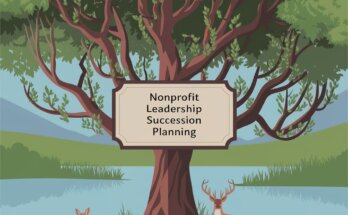This blog post shares practical time management tips for nonprofit leaders to help you maximize your productivity and make a more significant impact in your community.
Time is one of the most valuable resources for nonprofit leaders, yet it often feels like there are never enough hours in the day. With multiple tasks to juggle—like fundraising, team management, and community outreach—effective time management is essential for success.
Understanding the importance of time management is the first step toward becoming a more effective leader. When you manage your time well, you can achieve more in less time, reduce stress, and foster a positive work environment for your team.
Moreover, good time management allows you to allocate resources effectively and stay focused on your organization’s mission.
Tip #1: Set Clear Goals and SMART Objectives
Setting clear, actionable goals is the foundation of effective time management. When you know what you want to achieve, you can prioritize your tasks and focus your efforts accordingly. Use the SMART criteria—Specific, Measurable, Achievable, Relevant, and Time-bound—to create goals that guide your actions.
Example: Instead of saying, “We want to increase donations,” set a SMART objective: “We will raise $15,000 for our community program by the end of the quarter through a targeted fundraising campaign.” This clarity not only helps you stay focused but also makes it easier to measure your progress.
Tip #2: Prioritize Tasks Using the Eisenhower Matrix
One of the most effective tools for prioritizing tasks is the Eisenhower Matrix. This method divides tasks into four categories:
- Urgent and Important: Do these tasks immediately.
- Important but Not Urgent: Schedule these tasks.
- Urgent but Not Important: Delegate these tasks if possible.
- Neither Urgent nor Important: Eliminate these tasks.
Example: Imagine you have a grant application due soon (urgent and important) and a team meeting (important but not urgent). Use the matrix to decide what to tackle first. This approach helps you focus on what truly matters, reducing stress and enhancing productivity.
Tip #3: Use Project Management Tools
In the fast-paced world of nonprofits, using project management tools can streamline your workflow. Software like Trello, Asana, or Monday.com helps you organize tasks, set deadlines, and track progress.
Example: If you’re planning an event, you can create a project board with tasks like venue selection, marketing, and volunteer coordination. Assign these tasks to team members, set due dates, and monitor progress in real time. This clarity helps ensure that everyone is on the same page.
Embracing Delegation
Let’s pause for a moment to share the story of a nonprofit leader named Lisa.
Lisa runs a small environmental organization. For years, she took on too much herself—organizing community cleanups, writing grant applications, and managing social media. But soon, she felt overwhelmed and exhausted.
One day, during a team meeting, she decided to ask her staff for help. She delegated social media management to a tech-savvy intern and assigned grant writing to a volunteer with experience in that area.
By embracing delegation, Lisa discovered that her team had valuable skills she hadn’t tapped into before. The intern created engaging content that increased their online presence, and the volunteer wrote a successful grant proposal that secured funding for their next project.
Lisa’s story shows that time management isn’t just about organizing your schedule; it’s about empowering your team and maximizing their potential.
Tip #4: Block Your Time
Time blocking is a technique that involves scheduling specific blocks of time for different tasks throughout your day. This method helps you concentrate on one task at a time, minimizing distractions and improving focus.
Example: If you know you work best in the morning, reserve the first two hours of your day for high-priority tasks like writing grant proposals or planning strategies. During this block, turn off notifications and avoid checking emails. This focused approach allows you to accomplish more in a shorter amount of time.
Tip #5: Practice the Pomodoro Technique
The Pomodoro Technique is a time management method that encourages people to work in focused bursts. Work for 25 minutes, then take a 5-minute break. After completing four cycles, take a longer break of 15-30 minutes. This approach helps maintain high levels of productivity and reduces burnout.
Example: While drafting a project report, set a timer for 25 minutes and focus solely on writing. When the timer goes off, take a short break to recharge. This method not only makes long tasks feel more manageable but also boosts your overall productivity.
Tip #6: Schedule Regular Check-Ins
Regular check-ins with your team help keep everyone accountable and aligned with your organization’s goals. These meetings don’t have to be lengthy; even a brief 15-minute daily huddle can ensure that everyone knows their priorities for the day.
Example: If you have a team of volunteers, hold a quick morning meeting to discuss the day’s tasks and any challenges they may be facing. This fosters open communication and ensures that everyone feels supported, which ultimately leads to better time management.
Tip #7: Learn to Say No
As a nonprofit leader, it’s easy to feel pressured to accept every invitation, request, or opportunity that comes your way. However, learning to say no is a vital part of time management. By prioritizing your commitments, you can focus on what truly aligns with your organization’s mission.
Example: If you receive an invitation to speak at an event that doesn’t align with your goals, consider declining politely. This allows you to invest your time in initiatives that are more beneficial to your organization and helps prevent burnout.
Tip #8: Set Boundaries for Work-Life Balance
Maintaining a healthy work-life balance is crucial for long-term success. Establishing clear boundaries between work and personal time allows you to recharge and prevents burnout.
Example: If you typically work late into the evening, set a firm cutoff time for your workday. Communicate this boundary to your team and encourage them to respect it as well. You’ll find that taking time for yourself enhances your productivity during work hours.
Tip #9: Review and Reflect
Taking time to review your accomplishments and reflect on what worked (and what didn’t) is an essential aspect of time management. Schedule regular check-ins with yourself to assess your progress and make adjustments as needed.
Example: At the end of each week, spend 30 minutes reviewing your goals and tasks. What did you achieve? What could have gone better? By understanding your successes and challenges, you can refine your strategies for the future.
Tip #10: Invest in Self-Care
As a nonprofit leader, you are passionate about your work, but it’s important to prioritize your well-being. Investing in self-care—whether through exercise, hobbies, or relaxation—can help you recharge and improve your overall effectiveness.
Example: Set aside time each week for activities that bring you joy, such as going for a walk, practicing yoga, or reading a book. This time spent on self-care will help you return to work refreshed and ready to tackle challenges.
Empowering Yourself as a Nonprofit Leader
Effective time management is an essential skill for nonprofit leaders who want to maximize their impact while maintaining a healthy work-life balance. By implementing these tips—you can enhance your productivity and create a positive work environment for your team.
Remember, managing your time effectively is about making thoughtful choices that align with your mission and empower your team.
For more expert tips and resources tailored to nonprofit leaders, subscribe to the Nonprofit Navigators Newsletter. Join our community and gain access to job opportunities, grant opportunities, exclusive webinars, and events designed to support and empower nonprofit professionals like you. Take control of your time and watch your nonprofit thrive!
Additional Resources:
- The Small Business’s Guide to Winning Grants
- Request for Proposal Success: How to Write Proposals That Win
- The Ultimate Guide to Federal Grant Applications: Techniques for Success
- Digital Marketing for Nonprofits: A Comprehensive Guide to Boosting Your Impact Online
- Mastering Online Fundraising: A Nonprofit’s Guide to Digital Success




